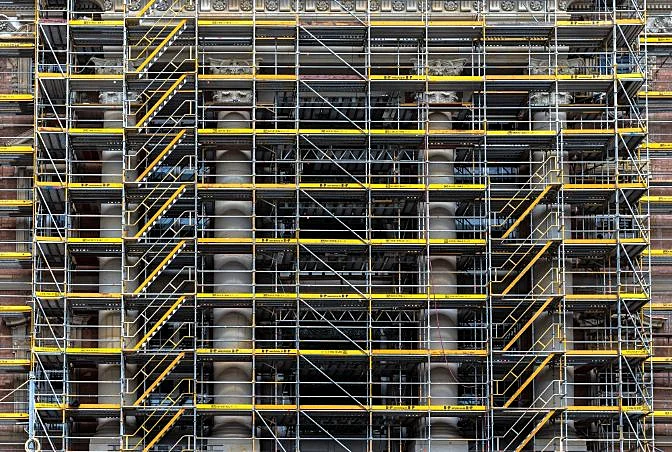Discovering the Various Kinds of Scaffolding Used in Building Jobs
The construction market relies heavily on numerous kinds of scaffolding to satisfy details task requirements, each offering distinctive advantages and applications. Traditional structure scaffolding offers a tough foundation for general tasks, while suspended scaffolding is essential for work on high-rise structures.

Traditional Frame Scaffolding
Conventional frame scaffolding is among the most widely used techniques in the building and construction sector due to its toughness and adaptability. This system includes straight and vertical frameworks that are put together to produce a secure system for products and employees. The major elements include upright articles, horizontal ledgers, and angled dental braces, which together supply a strong framework that can sustain significant loads.
One of the key advantages of typical structure scaffolding is its versatility to different construction tasks, ranging from household buildings to large business structures. The modular design enables very easy setting up and disassembly, making it effective for both lasting and short-term jobs. Additionally, the system can be tailored in height and size, suiting various structure designs and website conditions.
Safety is paramount in scaffolding applications, and traditional frame systems are equipped with guardrails and toe boards to prevent drops and make sure worker protection. Furthermore, regular examinations and adherence to safety guidelines are important in maintaining the honesty of the scaffold. Generally, traditional framework scaffolding remains an essential choice in the building industry, offering a trustworthy platform for labor and enhancing total project efficiency

Suspended Scaffolding
Put on hold scaffolding supplies an one-of-a-kind remedy for building projects that require access to raised surface areas, especially in scenarios where standard framework scaffolding may be unwise. This kind of scaffolding is usually suspended from the roof or upper levels of a framework, using a system of platforms, ropes, and pulley-blocks to produce a functioning area that can be adapted to numerous heights.
One of the main benefits of suspended scaffolding is its versatility. It can be easily rearranged or decreased to accommodate changes in building and construction needs, making it ideal for jobs such as home window setup, façade job, and maintenance on skyscrapers. Furthermore, the minimal footprint of put on hold scaffolding enables much better usage of ground space in metropolitan settings, where room is typically restricted.
Safety and security is an essential consideration in using suspended scaffolding. Correct rigging and anchoring systems need to be utilized to make certain stability and protect against mishaps. Operators needs to additionally be trained in the safe use this equipment. Overall, put on hold scaffolding gives a efficient and effective service for accessing hard-to-reach areas in numerous building circumstances, boosting both productivity and safety on website.
System Scaffolding
System scaffolding, usually considered as a modern-day service in the scaffolding sector, contains pre-engineered parts that can be rapidly set up and adapted for numerous construction projects. Scaffolding. This sort of scaffolding is identified by its modular layout, which permits versatility and efficiency on work sites, accommodating architectural demands and various elevations
Commonly made from high-strength steel or aluminum, system scaffolding supplies improved toughness and security. The parts consist of vertical messages, straight ledgers, and diagonal dental braces, which adjoin safely, guaranteeing a robust framework. The design typically incorporates standardized installations, streamlining assembly and disassembly procedures, consequently lowering labor time and costs.

Rolling Scaffolding
Rolling scaffolding is a flexible option to typical fixed scaffolding, made for flexibility and simplicity of usage on construction websites. This kind of scaffolding contains a platform supported by structures with wheels, permitting employees to quickly move it as needed. The mobility feature significantly enhances performance, as it decreases downtime associated with constructing and dismantling repaired scaffolding.
Typically constructed from lightweight products such as aluminum or steel, rolling scaffolding offers a tough yet mobile remedy for tasks calling for constant repositioning - Scaffolding. It is especially beneficial in jobs such as painting, drywall installment, and electrical work, where access to numerous heights and locations is necessary
Security is extremely important in rolling scaffolding design, with functions such as securing wheels to stop unintentional activity when in operation, and guardrails to shield workers from drops. Furthermore, numerous models are adjustable in elevation, accommodating numerous task requirements.
Cantilever Scaffolding

The design of cantilever scaffolding usually involves making use of brackets or arms secured to a building or structure, making it possible for the system to expand exterior safely. Safety and security is extremely important; hence, these scaffolds must be crafted to withstand ecological conditions and numerous tons. Regular assessment and upkeep are important to make sure architectural integrity and employee safety and security.
Cantilever scaffolding is preferred for its versatility and reliable usage of room, making it a popular selection in metropolitan environments where space constraints prevail. In addition, it helps with less complicated access to high altitudes, eventually contributing to the read the article overall performance of construction jobs. As with all scaffolding types, correct training and adherence to safety and security requirements are crucial for employees making use of cantilever scaffolding.
Conclusion
Standard frame scaffolding offers stability, while put on hold scaffolding uses flexibility for raised jobs. System scaffolding assists in fast setting up, and rolling scaffolding enhances movement for varying job settings.
Traditional frame scaffolding gives a sturdy structure for general jobs, while put on hold scaffolding is necessary for job on high-rise frameworks.Moving scaffolding is a versatile choice to traditional set scaffolding, developed for movement and convenience of use on building and construction sites. As with all scaffolding kinds, proper training and adherence to safety and security standards are critical for employees utilizing cantilever scaffolding.
Conventional frame scaffolding gives stability, while put on hold scaffolding supplies flexibility for raised jobs. System scaffolding helps with fast setting up, and rolling scaffolding improves flexibility for varying job atmospheres.